When you get a new guitar, sometimes the controls can be kind of confusing, whether it’s your first guitar ever, or if you’re a more experienced player. It can take some time to really figure out the controls, and how exactly to use them to get the perfect tone that you’re after.
In this article, I’ll go through, step-by-step, what each knob, switch and control on a Strat does, and how to use them to get a different kind of sound. So let’s get started.
Quick Guide
Stratocasters have three main control types, the pickup selector, tone controls, and a volume control.
The Strat’s pickup selector allows you to activate the bridge, middle and neck pickups, either alone or in different combinations.
There are two tone controls on a Strat, which adjusts how bright the tone is. On modern Strats, the upper tone control adjusts the neck and middle pickups, and the lower tone control adjusts the bridge pickup.
The volume control allows you to adjust the overall volume of the guitar, it also affects the brightness of the tone. If the volume control is on full, the tone will be brightest and loudest. When you turn the volume control down, it get’s quieter and the tone will sound less bright.
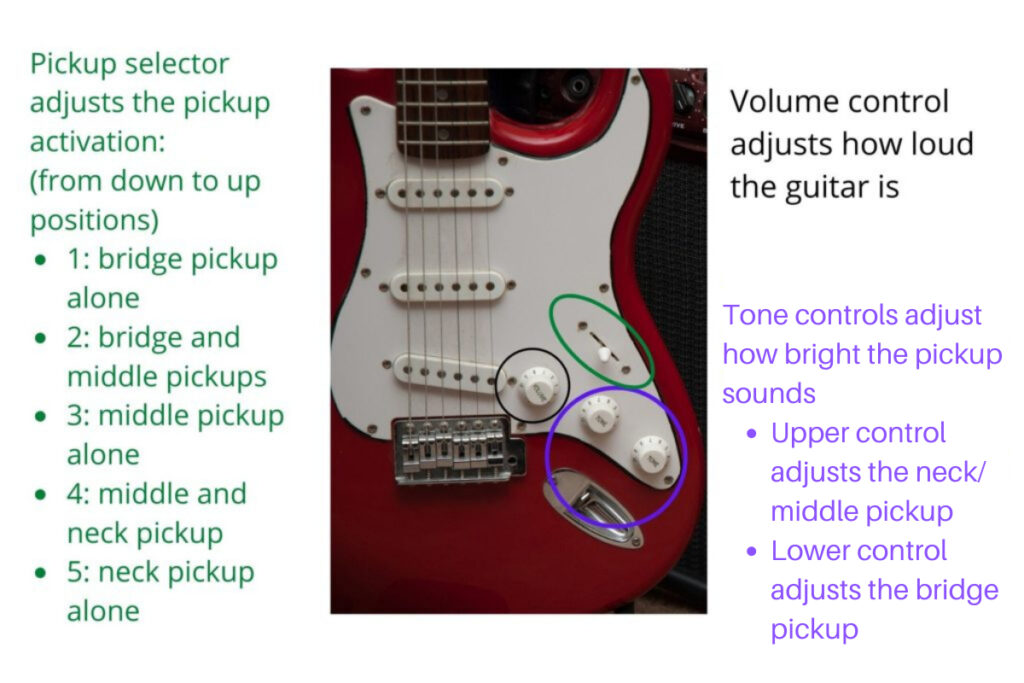
Pickup Selector
First, let’s talk about the pickup selector. The Stratocaster has three single coil pickups, one placed near the neck, one near the bridge, and one in the middle. Despite the fact that, in most cases, the pickups are identical, they all sound different due to their placement.
The bridge pickup sounds sharper and brighter, whilst the neck pickup has a warmer and more mellow tone. The middle pickup offers a tone that’s somewhere in between the two. Check out this post on pickup position and why it’s important to learn more about this topic.
You can switch between each pickup by using the pickup selector. Check out the diagram below.
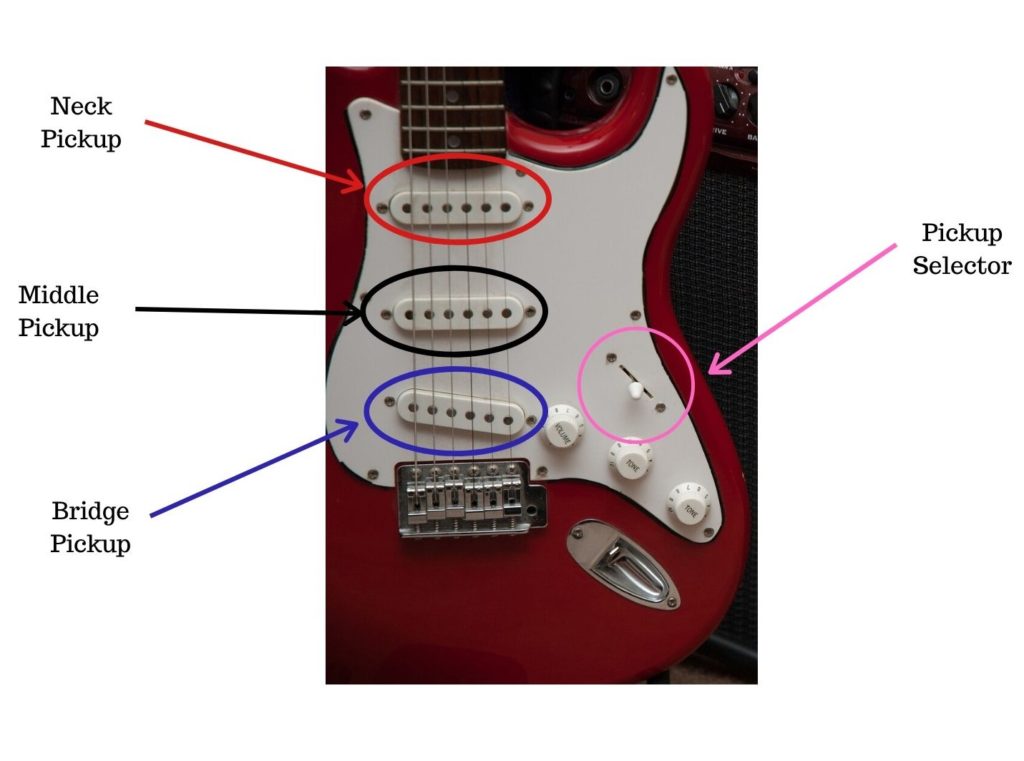
Things get a little more complicated here though. If you’ve ever used a Strat’s pickup selector blade, then you’ll know that there are actually five possible positions, not just three which correspond to each pickup type.
That’s because you can use this pickup selector to activate two pickups at a time. This gives you more versatility and options when it comes to dialling in the perfect tone. It’s useful if for example, the bridge pickup sounds a bit to sharp, and the middle sounds a bit too warm. In this case, you can simply activate both pickups to get a more balanced tone.
So here’s what the 5 way-pickup selector actually does.
- Position 1: Bridge pickup only
- Position 2: Bridge and middle pickups in combination
- Position 3: Middle pickup only
- Position 4: Middle and neck pickup in combination
- Position 5: Neck pickup only
This 5-way pickup selector is one of the best things about having a Strat. It allows you to create really great tones that are pretty unique to the Stratocaster.
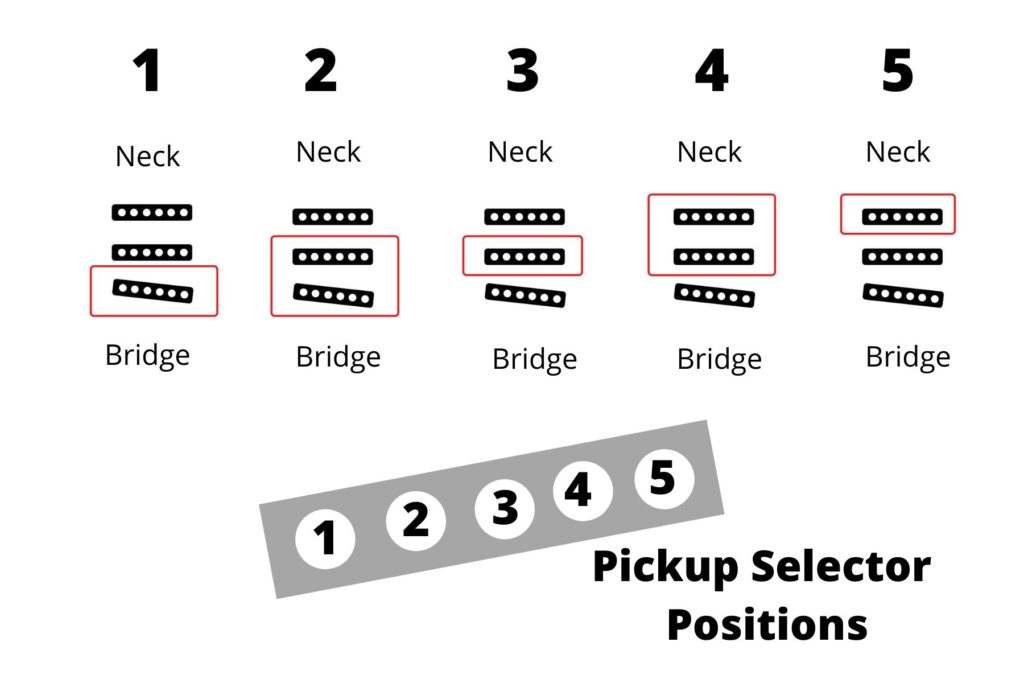
Which pickup position should you use?
This really depends on what type of tone you want. If you want something bright, that favours treble frequencies, then positions 1 and 2 will probably work best. If you want something more bassy and mellow, then positions 4 and 5 are better. Position 3 will offer you the most balanced tone.
Generally, positions 1 and 2, which activate the bridge pickup, are great for when you’re using more overdriven or distorted tones, or if you’re playing lead guitar. These pickup positions allow you to cut through the mix a bit more and give your tone more life.
A lot of players use positions 4 and 5, which activate the neck pickup, for cleaner tones, to avoid them becoming to harsh and bright, and for rhythm guitar to give you a warmer tone.
There are no rules though! Try each position and see which sound works best for you.
Tone Controls
There’s a lot of mystery surrounding what the tone controls actually do on a Strat. So let’s clear it all up here.
The Stratocaster has two tone controls. These control the treble frequencies that are sent to your amplifier. Treble frequencies are high-end frequencies, and they’re what makes your tone sound bright and sharp, and allows the notes to be heard more separately. Essentially, they give clarity and crispness to your tone.
You can turn the tone controls down if you want to reduce the treble frequencies, making the tone sound a bit less harsh, and a bit more mellow.
What do the tone controls on a Strat actually do?
On most modern Stratocasters, the top tone control, adjusts the tone of your neck and middle pickups. And the bottom tone control, adjusts the tone of your bridge pickup.
You can use the controls to adjust the sharpness of the neck pickup and middle pickups when they’re activated on their own, or both together.
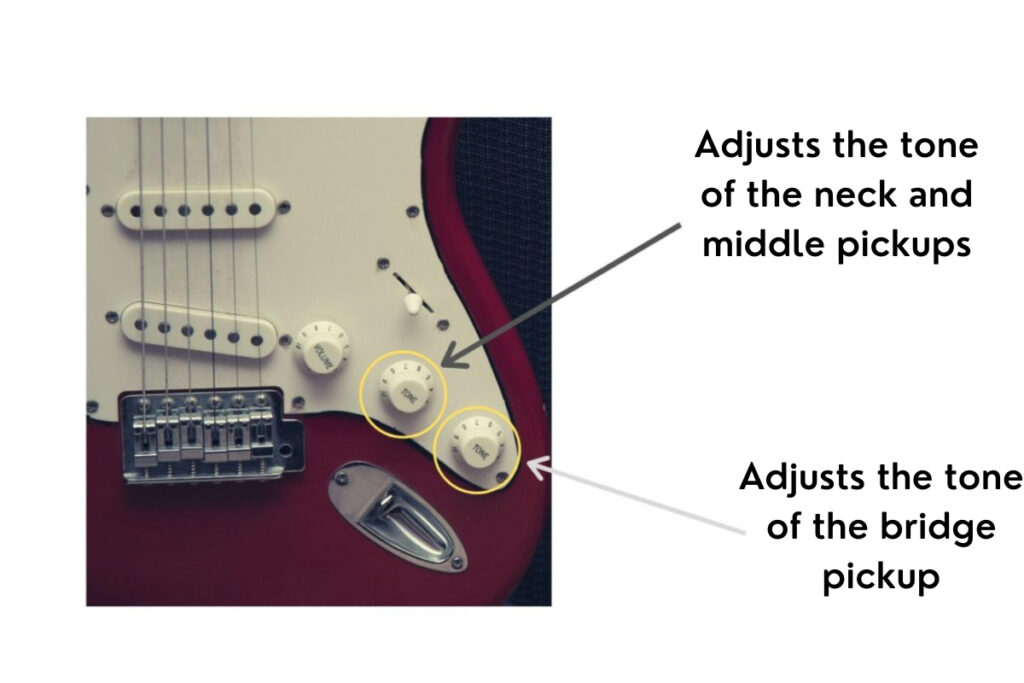
So what’s the advantage of having two tone controls?
Let’s take an example, if you were only using the neck pickup, and you wanted to really make it sound a lot more mellow, then you could roll down the upper tone control.
This works the same when you’re using your bridge pickup, and you want to make it sound more mellow.
You can also use the tone controls when using position 2 on the pickup selector, so both the bridge and middle pickups are activated. So for example, you could reduce the sharpness of the bridge pickup only, whilst keeping the treble at maximum for the middle pickup.
It basically just gives you more versatility.
What about older Stratocasters?
Many older Stratocaster models did not feature the tone controls described above.
Instead, the upper tone control was used to adjust the neck pickup, and the lower tone control was used to adjust the middle pickup, and there was no tone control for the bridge pickup.
Fender changed this recently on most of their Stratocasters to controls described above. If you have an older Strat which does not have a bridge tone control then it is possible to re-wire your guitar so that you can use the tone controls on the bridge pickup instead.
If you want to do this, then take your guitar to an experienced professional to take a look and make the switch.
Volume Control
Now let’s move onto the volume control. So this one is pretty obvious, but it adjusts the volume of the signal your guitar produces.
It’s handy to have a volume control on your actual guitar, as it means you can adjust it mid-song without having to mess about with your amp.
As well as affecting how loud your guitar is, the volume control will also adjust the tone. But this is an indirect effect.
If you turn down the volume control, you’ll lose some of the treble frequencies, making the tone sound less bright and sharp. Similarly, to how turning the tone controls affects your guitar’s sound.
Tremolo Arm
Finally, an often overlooked part of the Strat when it comes to the controls, is the tremolo arm. This is a really handy feature of the Strat.
It works pretty simply, and allows you to change the pitch of the strings by just pulling up or pushing down on the arm.
It works by increasing the tension on the strings, when you pull up on the tremolo arm, causing the pitch to sharpen. Then when you push down on the arm, the strings become less tense, causing the pitch to become flatter.
You’ll often find the tremolo arm being referred to as a whammy bar, or trem. They all mean the same thing, and they’re found on floating bridge types.
Check out this post on the different bridge types to learn more about this topic and why it’s so important to your guitar’s sound.
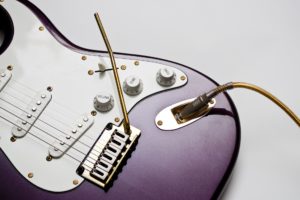
More FAQs
Don’t worry if you still have a few questions about how your Strat works. Take a look at these posts to give you some more answers.
So there you go! That’s how to use a Strat’s controls to get the best tone! I hope you’ve found this article helpful, thanks for reading. Here are some other posts you might find useful:
If you really want to improve your guitar playing then I recommend checking out Guitareo. You can sign up for a free 30-day trial here to get access to all the online lessons and start making real progress today
